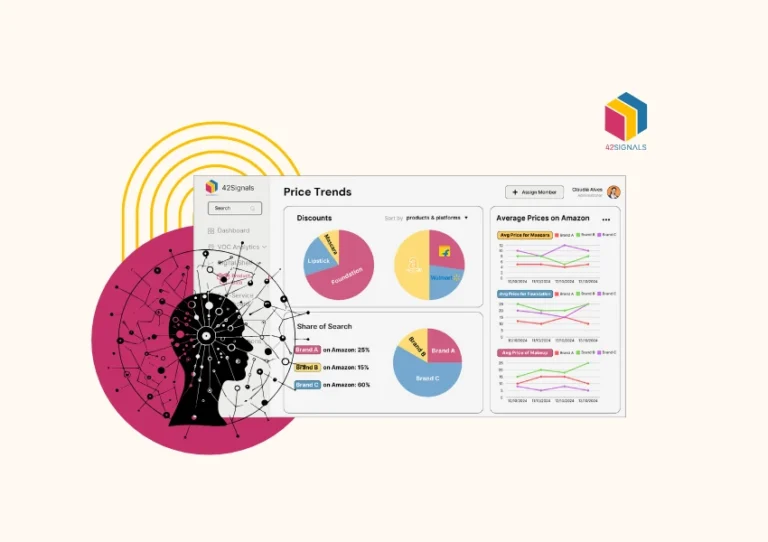Competitive Intelligence
Competitive Intelligence (CI) is the crucial process of collecting, analyzing, and using information about competitors to make strategic business decisions. It equips companies with insights into market dynamics and competitor strategies, empowering them to anticipate moves and respond proactively. CI methods include:
- Monitoring competitor’s digital and social media presence.
- Analyzing market trends and consumer behavior.
- Gathering data from industry reports, news, and events.
In essence, CI is not espionage but an ethical business practice, essential for staying ahead in a competitive landscape. It enables firms to refine their strategies, reduce risks, and uncover new opportunities.

Image Source:FourWeekMBA
How to Gather Competitive Insights?
Gathering competitive insights begins with identifying relevant data sources. Here are some strategies:

Image Source: Paperflite
• Monitor Social Media
Analyze competitors’ social media for customer engagement and content strategy insights.
• Engage in Online Communities
Join industry forums and groups to understand current discussions and sentiments.
• Review Public Records
Investigate patent filings and regulatory documents for future plans.
• Study Financial Reports
Examine quarterly and annual reports for financial health and strategic direction.
• Conduct Surveys
Gather direct feedback from customers about competitor products and services.
• Use Analytics Tools
Implement web analytics to track competitors’ online presence and performance.
• Attend Industry Events
Network and collect information from conferences and trade shows.
Through these methods, companies can accumulate a wealth of competitive intelligence to inform their strategic decisions.
Competitive Intelligence Tools & Techniques
Businesses employ various techniques and tools to analyze competitors. Staying ahead requires:
- Competitor benchmarking, assessing rivals against specific performance criteria.
- Utilizing SWOT analysis to identify competitors’ strengths, weaknesses, opportunities, and threats.
- Market segmentation to recognize the different target audiences competitors are focusing on.
- Digital analysis tools, such as SEMrush or Ahrefs, to track online presence and search rankings.
- Social listening platforms like Brandwatch or Mention, for real-time tracking of competitors’ social media engagement.
- Leveraging customer feedback on forums and review sites to gauge competitors’ service quality.
- Assessing financial reports and investor presentations to understand competitors’ strategies and performance.
- Participating in industry events, an opportunity to observe competitors in action.
- Conducting mystery shopping to experience competitors’ customer service firsthand.
These practices ensure a comprehensive understanding of the competition’s tactics and performance.
Turning Competitive Insights into Actionable Strategy
Once competitive intelligence is gathered and analyzed, it must be transformed into a strategic action plan. Companies should:
- Identify emerging trends and anticipate market shifts
- Assess their product positioning and adjust to fill gaps
- Tailor communication and marketing approaches to meet consumer demands
- Optimize operational efficiencies to improve productivity
- Allocate resources to areas with the highest potential return on investment
By synthesizing information into actionable strategies, businesses can maintain a competitive edge and drive growth in their respective industries.
Utilizing Technology: Competitive Intelligence Tools

Image Source: SEMRUSH
In the digital age, vast arrays of tools augment the competitive intelligence process. Companies implement software like SEMrush and Ahrefs for SEO and market analysis, revealing competitor website traffic and keyword strategies. Social listening platforms such as Brandwatch and Mention track brand mentions and assess market sentiment.
Intelligence databases like Hoover’s or Statista provide extensive data on industries and competitors. Additionally, firms leverage AI-driven tools like 42Signals for real-time market and competitor insights. These technologies enable businesses to gather, analyze, and act on competitor information more efficiently and effectively, gaining a strategic edge in their respective markets.
Maintaining a Competitive Edge: Continuous Monitoring and Analysis
To maintain a competitive edge, businesses must consistently engage in monitoring and analysis. This proactive approach involves:
- Systematic tracking of market trends, consumer preferences, and emerging technologies.
- Employing advanced analytical tools to interpret vast quantities of data swiftly and accurately.
- Benchmarking performance against competitors to identify areas for improvement.
- Conduct regular SWOT analysis to assess strengths, weaknesses, opportunities, and threats.
- Adapting strategies in real-time based on insights gained from ongoing competitive intelligence.
- Fostering a culture of continuous learning and agility within the organization to quickly respond to competitive challenges.
By consistently evaluating the competitive landscape, companies can anticipate shifts, refine their strategies, and remain ahead of the curve.
Measuring the Impact: How Competitive Intelligence Drives Success
Competitive intelligence (CI) plays a pivotal role in corporate strategy and performance. Companies measure the impact of CI through:
• Identify Market Trends
CI helps anticipate shifts and capitalize on them swiftly.
• Improve Product Offerings
Insights into competitor products inspire innovation and differentiation.
• Optimize Marketing Strategies
Understanding competitors’ marketing allows for more targeted and effective campaigns.
• Drive Strategic Planning
CI informs long-term strategies ensuring relevancy and competitiveness.
• Enhance Risk Management
Awareness of competitive moves mitigates potential market risks.
Implementing CI successfully can dramatically influence a company’s market position and profitability, demonstrating its indispensable role in driving success.
Conclusion
Competitive intelligence is essential for brands to succeed. Utilize digital tools for actionable insights by keeping up with industry news and monitoring competitors, enabling informed decisions and fostering growth. 42Signals offers Digital Shelf Analytics, enabling your brand to:
- Monitor competitors effectively
- Optimize product visibility and performance
- Make data-driven decisions for enhanced market positioning
Sign up for a free trial today and understand how your competitors fare in today’s marketplace.





